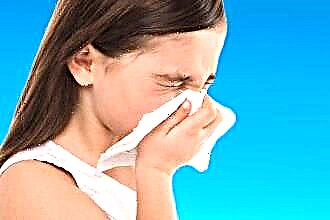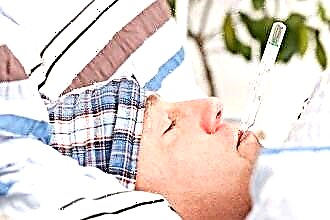A child's runny nose is stressful for the mother. However, you should not panic, because the correct treatment can quickly relieve children of unpleasant symptoms. To clear the mucous membrane and facilitate nasal breathing, it is necessary to regularly rinse the child's nose with saline.

A runny nose can be caused by:
- the impact of the cold factor. If a child is in a draft, strong wind or frost for a long time, the immune defense decreases and rhinitis develops;
- infection with viruses, bacteria. Infectious rhinitis can develop as a result of primary infection or activation of opportunistic microbes of the flora of the nasopharynx;
- allergic reaction. The abnormal response of the immune system to environmental factors is due to a genetic predisposition and concomitant diseases associated with immune dysfunction. Allergies can develop after inhalation of pollen, strong smells of perfume, hygiene products, contact with animals, or medication. Symptomatically, the pathology is manifested by lacrimation, swelling of tissues (lips, eyelids), itching of the eyes, nose, sneezing, redness of the conjunctiva, cough and skin rashes;
- deformation of the septum of traumatic, congenital or postoperative origin. If there is an obstacle to the movement of air through the nasal passages, it becomes difficult for the child to breathe, the physiological sanitation of the cavities is disturbed, which predisposes the occurrence of stagnation;
- vascular diseases, as well as diseases of the nervous, endocrine system. They are accompanied by an inadequate response of the blood vessels to the effects of environmental factors. The consequence of this may be a change in vascular tone and the occurrence of a vasomotor rhinitis;
- poor living conditions. If children inhale dry, polluted air for a long time, irritation of the mucous membrane can manifest itself in the form of rhinorrhea.
Saline from a common cold to children can be used from the first days of life.
The benefits of saline
 It is possible to rinse the child's nose with saline solution for both treatment and prevention of exacerbation in chronic rhinitis. It is absolutely safe, has no side effects and is widely prescribed in pediatrics. The medicine is used for:
It is possible to rinse the child's nose with saline solution for both treatment and prevention of exacerbation in chronic rhinitis. It is absolutely safe, has no side effects and is widely prescribed in pediatrics. The medicine is used for:
- sinusitis;
- chronic vasomotor, atrophic rhinitis;
- allergies;
- physiological rhinitis.
Rinse your nose with saline solution to:
- moisturizing the tissues of the nasal passages;
- removal of accumulations of mucus and pathogenic microorganisms;
- softening dry crusts, after which they are easily removed from the nose;
- reducing the severity of the inflammatory process;
- maintaining the optimal composition of the flora.
It is not recommended to inject saline into the nose for nosebleeds and purulent nasal discharge until the cause of the pathology is determined.
For rinsing the child's nose, it is recommended to use saline solutions, one of which is pharmacy sodium chloride. It is otherwise called physiological, since its composition is close to blood plasma. In medicine, both rinsing the nose with saline is useful, as well as its purpose for:
- dilution of drugs for inhalation using a nebulizer or drugs for injection;
- treatment of the wound surface, mucous membranes in the presence of allergies to other antiseptics;
- replenishment of fluid losses with vomiting, diarrhea in infectious diseases of the digestive tract. In case of poisoning, saline helps to normalize the water-electrolyte balance;
- moisturizing the nasopharyngeal mucosa during inhalation. This makes it possible to reduce the irritating effect of environmental factors on the nasal mucosa and improve drainage function.
In addition to saline, you can use other saline solutions for the common cold for children. For a cold in children, the nasal passages can be flushed with solutions based on sea salt. For a cold in children, Aqua Maris, Aqualor, Humer, Dolphin are used. They are much more expensive than saline and come in the form of a spray or drops.
For infants, it is recommended to use exclusively drip solutions, since a stream of liquid, when introduced into the nose, can penetrate into the auditory tube and ear cavity. This can cause otitis media. At an older age, you can use the aerosol form of drugs.
Can a cold be treated with home-made medicines? How to make saline nasal rinse? To prepare a saline solution, you need to take 10 g of salt, 940 ml of boiled water. The salt must be completely dissolved so that the crystals do not injure the tissue. The water should be warm so that it does not irritate the mucous membranes.
Rules of procedure
For the procedure to be beneficial, you need to know how to properly rinse your nose. Before the procedure, you should talk to the children, explain how the nasal cavities are washed. This will prevent the appearance of strong fear, and more thoroughly cleanse the mucous membrane. If the procedure is planned for a baby, it is advisable to cover his eyes so that he does not get scared.
How to rinse a child's nose with saline? There are several methods:
- for the procedure, you will need a kettle or a container with a spout. The child needs to bend over the sink or bathtub, turn his head to the right. A solution is poured into the kettle, which is then slowly introduced into the right nasal passage. Fluid will start pouring out through the other passage. If the solution enters the throat, you need to open your mouth to ensure that it flows out. It is impossible to use nasal breathing during the procedure, so children need to breathe through the mouth;
 infants need to drip saline into each passage, after which a special aspirator should be used. It has a soft tip to avoid tissue trauma. Having cleared the mucous membrane from the accumulation of snot, you need to drop two drops into the nose in order to additionally moisturize the surface.
infants need to drip saline into each passage, after which a special aspirator should be used. It has a soft tip to avoid tissue trauma. Having cleared the mucous membrane from the accumulation of snot, you need to drop two drops into the nose in order to additionally moisturize the surface.
Children are not allowed to rinse their nose by sucking in one nostril solution or infusing the solution under pressure from a syringe or syringe.
In addition to saline, other antiseptic preparations can be used to sanitize the nasal cavities:
- Furacilin. It is released in the form of a ready-made aqueous solution or in tablet form;
- Dioxidine;
- Miramistin - has a broad antiseptic effect, affects fungi, bacteria;
- Chlorhexidine in the form of a 0.05% solution.
Despite the safety of using the listed drugs, it is still recommended to first consult with a specialist.
Saline for prophylaxis
How often can you rinse your nose? To reduce the risk of snot from prolonged inhalation of contaminated air, to prevent exacerbation of chronic rhinitis, wash the child's nose twice a day.
If children are allergic to pollen, prevention should be started two weeks before the beginning of the flowering period. To do this, it is enough to rinse the nasal passages three times. One procedure consumes approximately 120 ml of solution.
In the acute period of the disease, you can wash the mucous membrane every two hours (depending on the severity of rhinorrhea, the condition of the child). If the treatment of rhinitis involves the use of nasal drugs with an antibacterial or vasoconstrictor effect, you should first flush the passages with a saline solution.
In addition to cleansing the mucous membrane with saline, the prophylactic complex includes:
- creating a comfortable microclimate in the children's room. To moisturize the mucous membrane and facilitate nasal breathing, it is necessary to maintain the humidity in the room at 65%. The temperature should not exceed 20 degrees.You can humidify the air with a humidifier, hang wet clothes over the battery, or put several containers of warm water in the children's room;
- regular cleaning and ventilation can reduce dust concentration and provide oxygen access. Cleaning for allergies is especially important, thereby reducing the amount of allergens in the air;
- walks in the fresh air (even in frosty weather) make it possible to provide natural cleansing of the nose and saturate the internal organs with oxygen. Children should be dressed “according to the weather,” since both hypothermia and overheating are undesirable for them. Separately, it should be said about walking with allergic rhinitis. In windy weather, there is a large amount of pollen in the air, which is a provocateur for the development of allergies. In this regard, with hay fever, you need to give up walking and airing the room in strong winds;
- limiting communication with sick peers, especially during an epidemic of viral diseases;
- vitamin therapy - allows you to strengthen the immune defense and reduce the risk of developing the disease;
- proper nutrition. For babies, the most important thing is breastfeeding. With milk, protective immunoglobulins are transmitted, thanks to which the unformed child's immunity can resist microbes. If a child is bottle-fed, he is more susceptible to infectious diseases. At an older age, you need to control the nutrition of children, limiting the use of pastries, sweets, chips, carbonated drinks. Fresh fruits, vegetables, herbs, cereals, dairy products and fish should be added to the diet. By getting enough vitamins and minerals, the immune system will be strong and less susceptible to infections.
Now you know how to rinse the nose for infants and older children. The procedure can be carried out for therapeutic or prophylactic purposes. Sometimes saline lavage is the only treatment, for example, for physiological rhinitis.

 infants need to drip saline into each passage, after which a special aspirator should be used. It has a soft tip to avoid tissue trauma. Having cleared the mucous membrane from the accumulation of snot, you need to drop two drops into the nose in order to additionally moisturize the surface.
infants need to drip saline into each passage, after which a special aspirator should be used. It has a soft tip to avoid tissue trauma. Having cleared the mucous membrane from the accumulation of snot, you need to drop two drops into the nose in order to additionally moisturize the surface.

